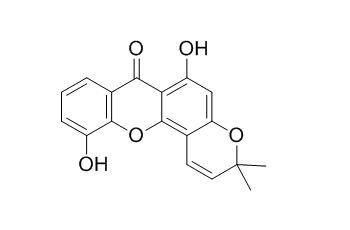6-Deoxyisojacareubin
6-Deoxyisojacareubin shows moderate inhibitory activity against the QGY-7703 cell line, with the IC50 value of 9.65 uM; it also possesses potency in the inhibition of protein kinase C (PKC).
Inquire / Order:
manager@chemfaces.com
Technical Inquiries:
service@chemfaces.com
Tel:
+86-27-84237783
Fax:
+86-27-84254680
Address:
1 Building, No. 83, CheCheng Rd., Wuhan Economic and Technological Development Zone, Wuhan, Hubei 430056, PRC
Providing storage is as stated on the product vial and the vial is kept tightly sealed, the product can be stored for up to
24 months(2-8C).
Wherever possible, you should prepare and use solutions on the same day. However, if you need to make up stock solutions in advance, we recommend that you store the solution as aliquots in tightly sealed vials at -20C. Generally, these will be useable for up to two weeks. Before use, and prior to opening the vial we recommend that you allow your product to equilibrate to room temperature for at least 1 hour.
Need more advice on solubility, usage and handling? Please email to: service@chemfaces.com
The packaging of the product may have turned upside down during transportation, resulting in the natural compounds adhering to the neck or cap of the vial. take the vial out of its packaging and gently shake to let the compounds fall to the bottom of the vial. for liquid products, centrifuge at 200-500 RPM to gather the liquid at the bottom of the vial. try to avoid loss or contamination during handling.
Evid Based Complement Alternat Med.2016, 2016:1230294
Int J Mol Sci.2023, 24(22):16465.
Food Chem.2018, 262:78-85
Hum Exp Toxicol.2023, 42:9603271231171642.
Saudi Pharmaceutical Journal2023, 31(12):101829
J Cell Mol Med.2023, 27(10):1423-1435.
Geroscience.2024, 01207-y.
Korean J. Medicinal Crop Sci.2022, 30(2):124-133
Nat Commun.2025, 16(1):4121.
J. Korean Wood Sci. Technol.2022, 50(5):338-352.
Related and Featured Products
1,3,5-Trihydroxy-4-prenylxanthone
Catalog No: CFN98891
CAS No: 53377-61-0
Price: Inquiry(manager@chemfaces.com)
6-Deoxyisojacareubin
Catalog No: CFN89446
CAS No: 26486-92-0
Price: Inquiry(manager@chemfaces.com)
Ugaxanthone
Catalog No: CFN96469
CAS No: 13179-11-8
Price: Inquiry(manager@chemfaces.com)
Isojacareubin
Catalog No: CFN96573
CAS No: 50597-93-8
Price: Inquiry(manager@chemfaces.com)
1,3,6,8-tetrahydroxy-4-(3-methyl-2-buten-1-yl)-9H-Xanthen-9-one
Catalog No: CFN92541
CAS No: 1319198-98-5
Price: Inquiry(manager@chemfaces.com)
6-Deoxyjacareubin
Catalog No: CFN96276
CAS No: 16265-56-8
Price: Inquiry(manager@chemfaces.com)
1,3,7-Trihydroxy-2-prenylxanthone
Catalog No: CFN98022
CAS No: 20245-39-0
Price: Inquiry(manager@chemfaces.com)
1,7-Dihydroxy-3-methoxy-2-prenylxanthone
Catalog No: CFN97264
CAS No: 77741-58-3
Price: Inquiry(manager@chemfaces.com)
1,5,8-Trihydroxy-3-methoxy-2-prenylxanthone
Catalog No: CFN99202
CAS No: 110187-11-6
Price: Inquiry(manager@chemfaces.com)
1,4,5,6-Tetrahydroxy-7-prenylxanthone
Catalog No: CFN99016
CAS No: 1001424-68-5
Price: Inquiry(manager@chemfaces.com)
Arch Pharm (Weinheim). 2013 Apr;346(4):314-20.
Efficient total synthesis and biological activities of 6-deoxyisojacareubin.[Pubmed:
23519477 ]
METHODS AND RESULTS:
6-Deoxyisojacareubin was directly synthesized in a six-step route with an overall yield of about 20%. In this route, the excellent site selectivity of this Claisen rearrangement-cyclization reaction cascade was achieved by inserting a bulky p-tosyl group into the free 1-OH, and in the last step, some efficient demethylation methods were explored. Furthermore, all synthesized intermediates including 6-Deoxyisojacareubin were evaluated for their inhibitory activity against the QGY-7703 cell line.
CONCLUSIONS:
Of these, compound 1 and 6-Deoxyisojacareubin showed moderate activities with IC50 values of 39.61 and 9.65 μM, respectively, when compared to the positive control 5-fluorouracil with an IC50 value of 11.24 μM. Further investigation using non-radioactive detection of protein kinase C (PKC) suggested that these two compounds possessed potency in the inhibition of PKC.
Nat Prod Res. 2017 Nov;31(21):2513-2519.
A new pyranoxanthone from Garcinia nervosa.[Pubmed:
28412841]
METHODS AND RESULTS:
Phytochemical studies on the stem bark of Garcinia nervosa has resulted in the discovery of one new pyranoxanthone derivative, garner xanthone (1) and five other compounds, 1,5-dihydroxyxanthone (2), 6-Deoxyisojacareubin (3), 12b-hydroxy-des-D-garcigerrin A (4) stigmasterol (5), and β-sitosterol (6).
The structures of these compounds were elucidated with the aid of spectroscopic techniques, such as NMR and MS.
CONCLUSIONS:
The crude extracts of the plant were assessed for their antimicrobial activity.



